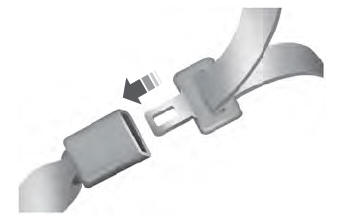Ford Escape: Anti-Lock Brake System (ABS) and Stability Control / Description and Operation - Anti-Lock Brake System (ABS) and Stability Control - Overview
Overview
The ABS and stability control systems are comprised of the following subsystems which assist the driver in maintaining control of the vehicle:
- ABS
- EBD
- EPB control
- ESC
- Hill start assist
- Hydraulic fade compensation
- RSC
- Selectable drive modes
- Supplemental braking assist
- Supports adaptive cruise control
- Supports collision avoidance
- Traction control
- Trailer sway control
The ABS helps maintain steering control by preventing the wheels from locking up during hard braking. The ABS also includes a brake assist function provides maximum brake system pressure during a severe braking event.
The EBD system helps maintain vehicle control by keeping a balanced braking condition between the front and rear wheels.
The ABS module is the ECU for the EPB system. For information on the electric parking brake system,
Refer
to: Parking Brake - System Operation and Component Description (206-05
Parking Brake and Actuation, Description and Operation).
The ESC system helps prevent skids or lateral slides by modulating brake fluid to the brake calipers and reducing engine torque.
The hill start assist system is designed to assist the driver during hill starts. Using the ABS , the hill start assist system holds the vehicle on an incline for a short period of time, allowing the driver to release the brake pedal and press the accelerator pedal without needing to use the parking brake.
Hydraulic fade compensation counteracts brake fade by providing additional brake pressure at the wheel ends if the maximum achievable vehicle deceleration is not reached when the driver applies significant force to the brake pedal.
The RSC system helps prevent excessive vehicle roll by modulating brake fluid pressure to individual brake calipers and reducing engine torque.
The selectable drive mode system helps maintain vehicle traction by adapting the responses of the engine, transmission, AWD system, the EPAS system, the ABS and the stability control system to the demands of the terrain.
The supplemental braking assist system uses the hydraulic pump motor and HCU to provide additional braking assist during a severe braking event.
The ABS
supports the adaptive cruise control system by applying the brakes as
necessary to maintain the distance gap set by the driver. For
information on the adaptive cruise control system,
Refer to: Cruise
Control - System Operation and Component Description (419-03B Cruise
Control - Vehicles With: Adaptive Cruise Control, Description and
Operation).
The ABS
supports the collision avoidance system by monitoring information and
precharging the brake system to allow the vehicle to stop in the
shortest distance possible. For information on the collision avoidance
system,
Refer to: Collision Warning and Collision Avoidance System -
System Operation and Component Description (419-03C Collision Warning
and Collision Avoidance System, Description and Operation).
The traction control system helps prevent loss of traction by reducing drive wheel spin during acceleration.
The trailer sway control system helps maintain vehicle stability while towing a trailer by detecting and aiding in the reduction of conditions causing trailer sway.
Some noise from the system and pulsations in the brake pedal are normal conditions during most ABS and stability control events. Also, longer than normal brake pedal travel may be experienced immediately following an ABS or stability control activation.
 Description and Operation - Anti-Lock Brake System (ABS) and Stability Control - System Operation and Component Description
Description and Operation - Anti-Lock Brake System (ABS) and Stability Control - System Operation and Component Description
System Operation
System Diagrams
ABS With EBB
Item
Description
1
ABS module
2
Hydraulic pressure sensor
3
EBB assembly
4
Wheel speed sensors
5
GWM
6
RCM
7
PSCM
8
BCM
9
AWD module
10
IPC
11
IPMA
12
HVAC module
13
GSM
14
PCM
15
SODR ..
Other information:
Ford Escape 2020-2025 Service Manual: Removal and Installation - Power Transfer Unit Input Shaft Seal LH
Special Tool(s) / General Equipment 204-069 (T81P-1104-C) Remover/Installer, Front Wheel Hub 205-153 (T80T-4000-W) Handle 307-557Installer, Ball BearingTKIT-2005U-FLMTKIT-2005U-LMTKIT-2006U-FLM/LMTKIT-2006UF/FM 308-968Installer, Input Shaft Seal 308-971Remover, Input Sleeve 308-972Installer, Input Sleeve 308-973Remover, PTU Input Sleeve Hyd..
Ford Escape 2020-2025 Service Manual: Diagnosis and Testing - Body Closures
Diagnostic Trouble Code (DTC) Chart Diagnostics in this manual assume a certain skill level and knowledge of Ford-specific diagnostic practices. REFER to: Diagnostic Methods (100-00 General Information, Description and Operation). Diagnostic Trouble Code Chart Module DTC Description Action BCM B11C4..
Categories
- Manuals Home
- 4th Generation Ford Escape Owners Manual
- 4th Generation Ford Escape Service Manual
- Electric Parking Brake
- Plug-In Hybrid Electric Vehicle Drive Modes
- Switching the Lane Keeping System On and Off. Switching the Lane Keeping System Mode. Alert Mode
- New on site
- Most important about car
Fastening the Seatbelts


